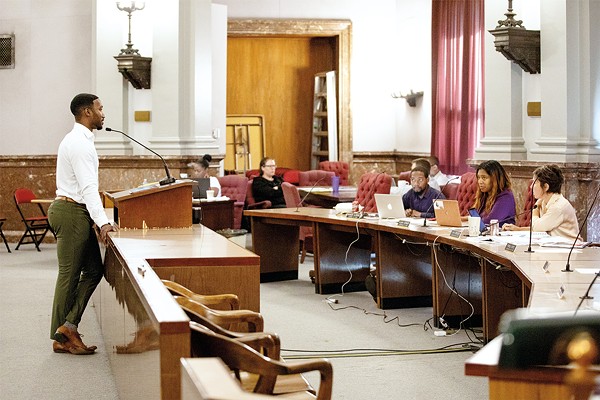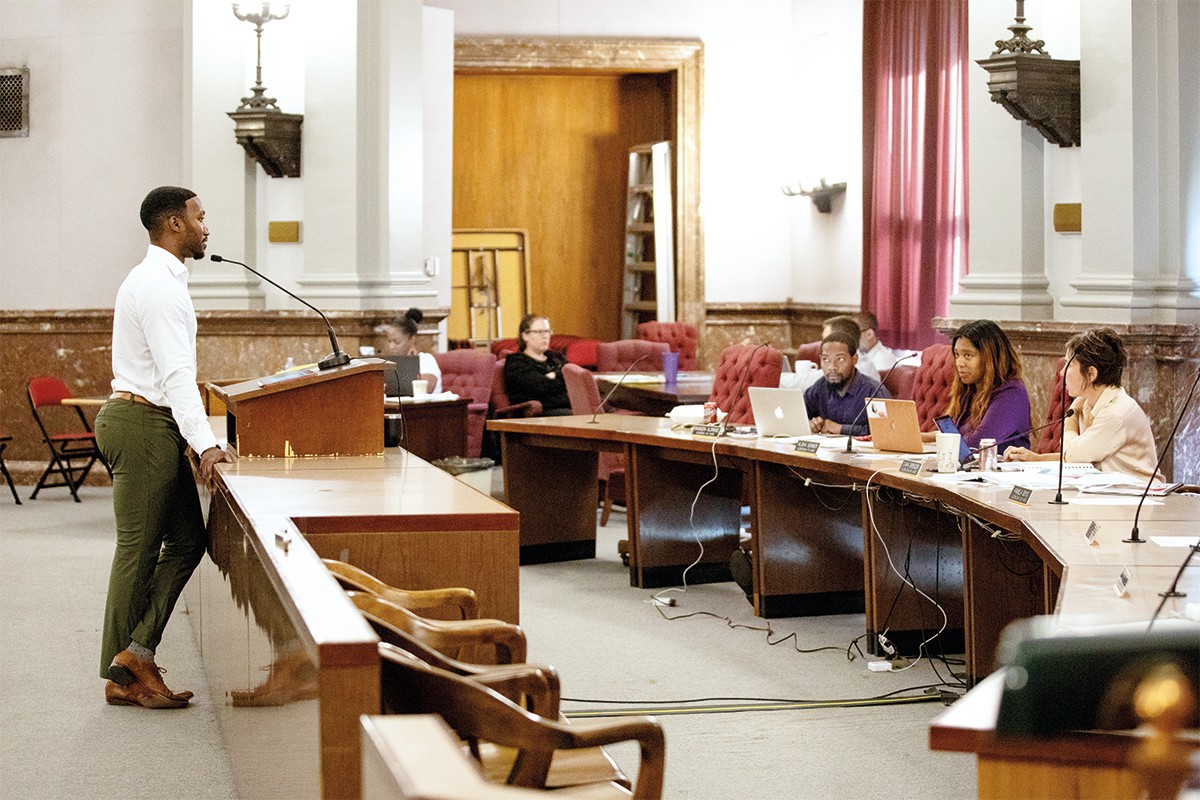Local News
Treasurer Defends College Kids to St. Louis School Board | St. Louis Metro News | St. Louis

[ad_1]

click to enlarge BRADEN MCMAKIN City Treasurer Adam Layne, who inherited College Kids from Mayor Jones, faced questions at a previous aldermanic meeting.
The College Kids Savings Account program is in trouble. City Treasurer Adam Layne earlier this week tried to save it.
Layne attempted to do so in the form of a six-page, single-spaced, nearly 3,500-word letter to Keisha Scarlett, the St. Louis Public Schools superintendent. It aims to rescue the 8-year-old program that earmarks city parking revenues to special bank accounts set up for city kids to use for college or trade school.
But Scarlett recently announced she was suspending St. Louis Public Schools’ participation in the program. Layne’s letter, which also went out Monday to district school board members, requested that Scarlett end the indefinite freeze she had placed on College Kids last month.
The school district’s freeze was prompted by a June 7 River City Journalism Fund investigation publishedin the RFT andSt. Louis Public Radio on June 7.
In her September 15 letter, Scarlett wrote the freeze would continue “until we gain a better understanding of its impact before proceeding.” Scarlett then put forward a series of questions about College Kids that touched on many program facets, including public engagement, account growth and average account balances.
Scarlett’s questions hew closely to the ones raised by the June 7 story about College Kids’ cost-effectiveness and engagement level. The story showed that only 15 percent of the more than 23,000 eligible students in the district were taking part, that the average account had grown to just $73, and that only the treasurer’s office was earning interest off the accounts — while students weren’t collecting a dime.
The program suspension on September 15 led the district to refuse to release identifying information about this year’s public school kindergarteners. The freeze did not affect students in the 14 charter schools also taking part in College Kids.
“A continued pause means that this current class of kindergarten students will graduate from high school missing out on a collective savings of $2.2 million toward their educational dreams,” Layne wrote in the letter, a copy of which was obtained by the RFT. “A continued pause means that there is one less driving force in the fight to break generational cycles of poverty for our most marginalized population, a population that reflects more than 85 percent of SLPS.”
click to enlarge Keisha Scarlett School Superintendent Keisha Scarlett began her job on July 1.
Antoinette “Toni” Cousins, the school board president, declined to discuss the letter or share it with the RFT.
“We need to review and assess it ourselves,” Cousins wrote to the RFT in a text message Monday night.
In a statement released Tuesday, SLPS spokesman George Sells wrote that Scarlett is reviewing Layne’s letter.
“This is, however, a matter for the Board of Education to decide, and we will follow their lead,” Sells wrote. “This will be discussed in a public session the time of which is still to be determined.”
Neither Layne nor his spokesperson returned repeated phone calls, emails or texts.
The school board plans to discuss the school district’s future with College Kids at its meeting set for Oct. 10, according to several board members.
Under the purview of the St. Louis Office of Treasurer, College Kids sets up college savings accounts and “seeds” them with a $50 donation for every kindergarten student enrolled in city public (and many charter) schools. The accounts are expected to grow through family and charitable donations, corporate philanthropy and incentives that students earn through good attendance and financial literacy classes.
Tishaura Jones set up the program in late 2015 while she served as treasurer, and it was one of her signature accomplishments during her successful run for mayor in 2021.
Layne’s letter uses positive numbers and program highlights to paint the program as a glowing success.
The letter notes that students enrolled in the program have saved a total of $1.1 million, and that the oldest group, SLPS eighth graders, have collectively saved nearly $187,000. Further, Layne notes that 600 students in this group are above the $50 seed level, while 30 families are “already at or above the $500 (goal), meaning that they’ve already hit and surpassed their savings goal a full four years ahead of schedule.”
Furthermore, the average balance for eighth-grade accounts is $129.45, which jumps to $240.94 among active savers, Layne wrote.
“The results are promising and encouraging,” he wrote.
Layne’s letter does not mention that his office has spent an average of almost $300,000 per year — a figure that includes seed deposits, incentives, staff salaries and donations — since the program began in late 2015. That represents more than $2 million.
In other words, to reach a College Kids savings total of $1.1 million, the treasurer’s office has had to spend about twice that sum in salaries and other overhead costs, raising questions about whether this makes sense as an investment for city residents.
These questions grow more stark when you consider that the treasurer’s office will likely spend at least another $1.5 million on the program before the first high school graduates touch any of the money, which won’t be until 2028 at the earliest.
Layne’s letter doesn’t answer another big question that Scarlett and the school board had for him: Whether Layne will comply with Scarlett’s demand, contained in the September 15 letter, that the treasurer’s office compensate the school district for the work employees will put in to oversee and manage records on behalf of the city’s forthcoming Guaranteed Basic Income program. A $5 million federally funded initiative, it aims to give $500 monthly stipends to 440 parents of city public school students over an 18-month period. The program has not yet launched.
Scarlett, in her Sept. 15 letter, asked the city “to redirect a portion of the funding used to hire independent staff for this initiative to compensate our SLPS staff for covering these additional responsibilities.” click to enlarge MIKE FITZGERALD Grandfather Joe Miklovic went public with concerns about College Kids earlier this summer after being unable to withdraw his grandson’s funds.
The College Kids program is an example of a Child Development Account, or CDA. Research into cures for long-term poverty — an academic field highly influenced by researchers affiliated with Washington University — has provided the intellectual feedstock for the dozens of state- and city-run CDAs that have sprung up nationwide.
One of the most oft-cited statistics in this field is one that Layne marshals in his letter as a central argument for preserving College Kids: Data show “that students with at least $500 saved for college are three times more likely to go to college and four times more likely to graduate from college.”
But a major debate divides this field: should the main goal of CDAs be to get kids from low-income families to develop the mindset that they’re going to college and to save for that goal?
Or should a CDA’s goal be something far bigger, but more nebulous, such as teaching families about financial literacy and how to develop long-term financial goals, such as saving money up for a college education or a house?
If the goal is the latter, then how to measure real progress in that direction?
It’s a question that up until recently neither Jones nor Layne showed any documented evidence of trying to answer when it came to St. Louis families. In the months of reporting before the RFT story about College Kids appeared in early June, Layne cited no surveys or other evidence showing how College Kids had changed the economic behavior of St. Louis families taking part in the program.
But Layne in his October 2 letter cites a “recent survey” of College Kids families showing that “94.5 percent stated that early college savings is important to their household, and 87 percent of those families said that the College Kids program is what sparked their college savings journey for their child.”
Layne added: “In fact, 63 percent say they would NOT have started this early on their child’s college savings journey without the College Kids program.”
Layne’s letter does not state when the survey occurred, how many people took part in it or what sort of questions they answered. Nor does he address the most difficult question of all: Has College Kids truly made a difference in participating families’ economic behavior?
Layne’s letter also fails to address another problem that has long beset College Kids: the absence of meaningful outside oversight.
Under the memoranda of understanding that launched the program more than eight years ago, a 12-member Core Program Committee was supposed to be set up and include one representative from St. Louis Public Schools and a representative or leader from at least one city charter school.
Training manuals from 2017 and 2019 for College Kids program employees also state that this 12-member Core Program Committee should meet to “discuss the structure and progress of the program.”
But that core committee was never formed, according to the treasurer’s own records. Meanwhile, the only other outside oversight panel — the 14-member Advisory Board — has little power.
Other major issues that beset College Kids — the lack of corporate and charitable support, and a proliferation of dormant accounts — Layne addresses only obliquely.
Layne reports in his letter that one company in 2021 donated $20,000 to support the College Kids program, while the office raised $25,000 on both GiveSTL Day and Giving Tuesday. The program’s banking partners collectively have donated “more than $100,000 just in the past 18 months,” he writes, while “this past year we secured a renewable, annual commitment of $125,000 from Wells Fargo to support the College Kids program…”
As for accounts that become dormant when students leave the district, Layne wrote, “At this point, we do not consider accounts abandoned, as we know transience is big in our region. 38 percent of K-12 public students move schools mid-year. That might be out of the district, out of the city, or the state.”
The accounts would be kept open, Layne noted in his letter, because of his experience as a city high school teacher, when he “would often witness the return of students to the district after years away. With our program, those students never lose their accounts and thus never lose the ability to save for their future.”
Perhaps the biggest long-term issue Layne did not address in his October 2 letter is existential in nature: the city’s alarming loss of school-age children, especially among Black families, a trend stemming from disruptions caused by the pandemic and an ongoing exodus of city residents toward St. Louis County and beyond.
St. Louis lost 44,000 school-age children between 2010 and 2020 — a 24 percent drop, according to the most recent census figures.
In the 2015-2016 school year, the treasurer’s office enrolled 3,118 students into College Kids accounts, records show. The program peaked two years later, with 3,610 new accounts.
But then, tracking closely to declines in overall district enrollment, the number of new College Kids accounts has dropped to just 2,307 accounts in 2022 — a decline of nearly 40 percent over five years.
Subscribe to Riverfront Times newsletters.Follow us: Apple News | Google News | NewsBreak | Reddit | Instagram | Facebook | Twitter | Or sign up for our RSS Feed
[ad_2]
Source link
Local News
Fenton Man Charged in Sword Attack on Roommate

[ad_1]

A warrant is out for a Fenton man’s arrest after he allegedly attacked his roommate with a sword.
Police say that on Sunday, Angelus Scott spoke openly about “slicing his roommate’s head” before he grabbed a sword, raised it up and then swung it down at the roommate.
The roommate grabbed Scott’s hand in time to prevent injury. When police arrived at the scene, they found the weapon used in the assault.
The sword in question was a katana, which is a Japanese sword recognizable for its curved blade.
This isn’t the first time a samurai-style sword has been used to violent effect in St. Louis. In 2018, a man hearing voices slaughtered his ex-boyfriend with a samurai sword. His mother said he suffered from schizoaffective disorder.
As for Scott, 35, the St. Louis County Prosecuting Attorney’s Office was charged yesterday with two felonies, assault first degree and armed criminal action. The warrant for his arrest says he is to be held on $200,000 bond.
Subscribe to Riverfront Times newsletters.Follow us: Apple News | Google News | NewsBreak | Reddit | Instagram | Facebook | Twitter | Or sign up for our RSS Feed
[ad_2]
Source link
Local News
Caught on Video, Sheriff Says He’s Ready to ‘Turn It All Over’ to Deputy

[ad_1]

Video of St. Louis Sheriff Vernon Betts taken by a former deputy suggests that the sheriff has a successor in mind to hand the reins of the department over to, even as Betts is in an increasingly heated campaign for reelection.
“I ain’t here for all this rigmarole,” Betts says in the video while seated behind his desk at the Carnahan Courthouse. “The Lord sent me here to turn this department around and I’m doing the best I can and I think I’ve done a good job. I’ve got about eight months and I’m going to qualify for my fourth pension.”
He goes on, “Right now I can walk up out of here and live happily ever after and forget about all this…and live like a king.”
The sheriff then says his wife has been in Atlanta looking at houses and that the other deputy in the room, Donald Hawkins, is someone Betts has been training “to turn it all over to him.”
Asked about the video, Betts tells the RFT, “My future plans are to win reelection on August 6th by a wide margin and to continue my mission as the top elected law enforcement official to make St. Louis safer and stronger. Serving the people of St. Louis with integrity, honor and professional law enforcement qualifications is a sacred responsibility, and I intend to complete that mission.”
The video of Betts was taken by Barbara Chavers, who retired from the sheriff’s office in 2016 after 24 years of service. Chavers now works security at Schnucks at Grand and Gravois. Betts’ brother Howard works security there, too.
Chavers tells the RFT that she was summoned to Betts’ office last week after Betts’ brother made the sheriff aware that she was supporting Montgomery. It was no secret: Chavers had filmed a Facebook live video in which she said she was supporting Betts’ opponent Alfred Montgomery in the election this fall. “Make the judges safe,” she says in the video, standing in front of a large Montgomery sign on Gravois Avenue. “They need a sheriff who is going to make their courtrooms safe.”
In his office, even as Chavers made clear she was filming him, Betts told Chavers he was “flabbergasted” and “stunned” she was supporting Montgomery.
“I don’t know what I did that would make you go against the preacher man,” he says, referring to himself. He then refers to Montgomery as “ungodly.”
Betts goes on to say that not long ago, he was walking in his neighborhood on St. Louis Avenue near 20th Street when suddenly Montgomery pulled up in his car and, according to Betts, shouted, “You motherfucker, you this, you that. You’re taking my signs down.”
Montgomery tells the RFT that he’s never interacted with Betts outside of candidate forums and neighborhood meetings.
“I don’t think anyone with good sense would do something like that to a sitting sheriff,” Montgomery says.
Montgomery has had campaign signs missing and on at least two occasions has obtained video of people tearing them down. (Chavers notes that the sign that she filmed her original Facebook video in front of is itself now missing.)
One man who lives near Columbus Square says that he recently put out two Montgomery signs, which later went missing. “If they keep taking them, I’ll keep putting them up,” he said.
Betts says he has nothing to do with the missing signs. In the video Chavers filmed in Betts’ office, Betts says that his campaign isn’t in a spot where it needs to resort to tearing down opponents’ signs.
“If you sit here long enough, a man is getting ready to come across the street from City Hall bringing me $500, today,” Betts says. “I’m getting that kind of support. I don’t need to tear down signs.”
Subscribe to Riverfront Times newsletters.Follow us: Apple News | Google News | NewsBreak | Reddit | Instagram | Facebook | Twitter | Or sign up for our RSS Feed
[ad_2]
Source link
Local News
St. Louis to Develop First Citywide Transportation Plan in Decades

[ad_1]

The City of St. Louis is working to develop its first citywide mobility plan in decades, Mayor Tishaura Jones’ office announced Tuesday. This plan seeks to make it easier for everyone — drivers, pedestrians, bikers and public transit users — to safely commute within the city.
The plan will bring together other city projects like the Brickline Greenway, Future64, the MetroLink Green Line, and more, “while establishing new priorities for a safer, more efficient and better-maintained transportation network across the City,” according to the release.
The key elements in the plan will be public engagement, the development of a safety action plan, future infrastructure priorities and transportation network mapping, according to Jones’ office.
The overarching goals are to create a vision for citywide mobility, plan a mixture of short and long-term mobility projects and to develop improved communication tools with the public to receive transportation updates. In recent years, both people who use public transit and cyclists have been outspoken about the difficulties — and dangers — of navigating St. Louis streets, citing both cuts to public transit and traffic violence.
To garner public input and participation for the plan, Jones’ office said there will be community meetings, focus groups and a survey for residents to share their concerns. The city will also be establishing a Community Advisory Committee. Those interested in learning more should check out at tmp-stl.com/
“Everyone deserves to feel safe when getting around St. Louis, whether they’re driving, biking, walking or taking public transit,” Jones said in a news release. “Creating a comprehensive transportation and mobility plan allows us to make intentional and strategic investments so that moving around St. Louis for jobs, education, and entertainment becomes easier, safer and more enjoyable.”
Subscribe to Riverfront Times newsletters.Follow us: Apple News | Google News | NewsBreak | Reddit | Instagram | Facebook | Twitter | Or sign up for our RSS Feed
[ad_2]
Source link
-

 Politics2 years ago
Politics2 years agoPrenzler ‘reconsidered’ campaign donors, accepts vendor funds
-
Board Bills1 year ago
2024-2025 Board Bill 80 — Prohibiting Street Takeovers
-

 Business3 years ago
Business3 years agoFields Foods to open new grocery in Pagedale in March
-

 Board Bills3 years ago
Board Bills3 years ago2022-2023 Board Bill 168 — City’s Capital Fund
-

 Business3 years ago
Business3 years agoWe Live Here Auténtico! | The Hispanic Chamber | Community and Connection Central
-

 Entertainment1 year ago
Entertainment1 year agoOK, That New Cardinals/Nelly City Connect Collab Is Kind of Great
-

 Entertainment3 years ago
Entertainment3 years agoSt.Louis Man Sounds Just Like Whitley Hewsten, Plans on Performing At The Shayfitz Arena.
-

 Entertainment1 year ago
Entertainment1 year agoSt. Louis’ New Museum of Illusions Is Ready to Book Your Visit





